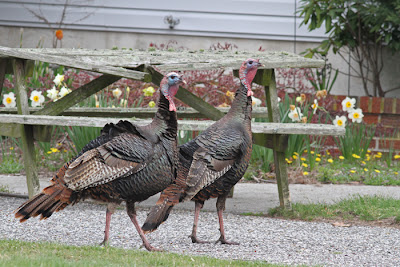Wild Turkeys on New England Road, Cape May today [photo by Mike Crewe].
So here's another picture to ponder on - and I don't know the full story for this one...
Common Loon wailing his way over Cape May Point State Park [photo by Mike Crewe].
At this time of year, Common Loons can regularly be seen flying over land in Cape May, but here's a couple of questions to ponder on. Why are Common Loons so willing to fly over land here but Red-throated Loons are not? And another thing to contemplate - why and when do you hear Common Loons calling in flight at Cape May? The spine-tingling call of a Common Loon is a fabulous sound and one that is quite regularly heard around Cape May at this time of year, but why do they call in flight? Also, do they do it randomly, or does it only happen at certain times of day, or even in certain weather conditions? I have a feeling in the back of my mind that they largely seem to do it when visibility is poor, on heavily overcast days or when sea mist is rolling in at the point - as has been the case on both occasions that I have heard the call recently. See what you make of it; next time you hear a loon call, check the weather and see if you spot a pattern - or maybe it's something else that sets them off...
A couple of days ago I heard my first Ovenbird of the year; my favourite North American bird (and well up there with Lanceolated Warbler as possibly the best bird in the world!), I almost invariably hear the first one just as the weather is warming up and I can start driving with the car window down. Today I chanced across two males duelling with each other, one either side of the road and each sticking up for its territorial rights. Knowing that this was likely to keep them a little preoccupied, I jumped out with the camera and decided to test again the old wives' tale that Ovenbirds are hard to see. Good old fashioned fieldcraft always comes to the fore with this species and after a bit of bad luck with some particularly snappy twigs, I suddenly found a bird just sitting there, out in full view with all the singing having come to a halt. So I pondered why this was and shortly came to the answer - the two males had come rather too close for comfort to each other! Perhaps I had inadvertently moved one to the edge of its neighbor's patch and it seemed that an impasse had set in. Here's the first bird I spotted...
The victor in today's Cape May allcomers event - what a stunning bird and always a highlight of a walk in the woods at this time of year. Ovenbirds are plentiful in deciduous and mixed woodland throughout eastern North America but the best time to really enjoy them is when they are newly arrived and pre-occupied with their busy lives [photos by Mike Crewe].
Recent Reports
The warbler floodgates haven't opened yet but they're certainly starting to leak at the seams. Several Prairie Warblers were singing on our Higbee Beach walk this morning and Belleplain gets a little better day on day. Higbee Beach also had at least two Eastern Kingbirds, a couple of showy, singing Brown Thrashers, a few Ruby-crowned Kinglets and a dayglow male Baltimore Oriole today. Heislerville added Wilson's Phalarope to its list of star birds today, while the offshore activity of Northern Gannets, Surf Scoters and Red-throated Loons continues unabated. Richard Crossley reported an adult Parasitic Jaeger off 2nd Avenue Jetty a couple of days ago so the beaches are well worth a check if you're in town this weekend.
Butterflies at Higbee Beach today included a Pearl Crescent and this newly emerged (but already a bit tatty) White-M Hairstreak. Though rather drab below, the brilliant metallic blue upperwings really do catch the eye when these little beasties fly. One or two Holly Azures are on the wing around the point now too, as well as Orange Sulphurs and a scattering of Mourning Coaks. Dragonfly time is imminent too so keep an eye out for Blue Corporals which started to emerge last weekend, as well as incoming Green Darners from the south [photo by Mike Crewe].




